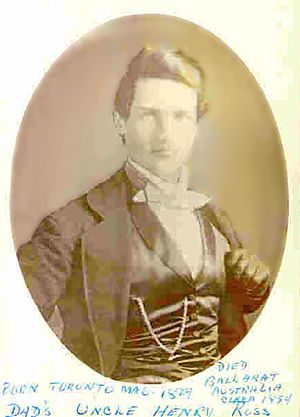Henry Ross facts for kids
Quick facts for kids
Henry Ross
|
|
|---|---|

Henry Ross, in a photo displayed by the Bendigo Fine Art Gallery
|
|
| Born | 1829 |
| Died | 5 December 1854 |
| Occupation | Gold miner |
| Known for | Eureka Rebellion |
Henry Ross (born 1829 – died 5 December 1854) was a gold miner from Canada. He played a key part in the Eureka Rebellion. This was a famous uprising at the Ballarat gold fields in the British Colony of Victoria. Today, Victoria is a state in Australia. Ross is especially remembered for helping to create the rebel miners' flag, known as the Eureka Flag.
Contents
Henry Ross and the Eureka Flag
Henry Ross was a gold miner who became an important figure in Australian history. He is known for his role in the Eureka Rebellion, a protest by gold miners in 1854. This event happened in Ballarat, a city in what was then the British Colony of Victoria. Ross is most famous for helping to create the iconic Eureka Flag.
Early Life and the Gold Rush
Henry Ross was born in 1829 in Toronto, a city in what was then called Upper Canada. This area later became part of the larger Province of Canada. Before coming to Australia, Ross was a gold miner in California. He joined the exciting California Gold Rush there.
Ross likely arrived in Melbourne, Australia, in November 1852. He traveled on a ship called the Magnolia. With him were Charles Doudiet and three other miners from Canada. They came to seek their fortune on the rich Australian goldfields.
The Eureka Flag's Story
On the goldfields, Henry Ross was known as the 'bridegroom' of the miners' flag. This special flag was called the Southern Cross flag. It was named after a group of stars called an asterism that can be seen in the Southern Hemisphere sky. The flag became a powerful symbol for miners who were protesting against the government in 1854.
No one knows for sure who first designed the flag. But Henry Ross was the one who took the design to three women. Their names were Anastasia Withers, Anne Duke, and Anastasia Hayes. He asked them to sew the flag. He needed it to be ready for an important meeting. This meeting was planned for 2:00 PM on Wednesday, November 29, 1854, at Bakery Hill.
The Oath and the Battle
On November 30, 1854, Henry Ross proudly unfurled the flag at Bakery Hill. He then led a march from Bakery Hill to the Eureka Stockade. About 1,000 miners, called 'diggers,' followed him. Some had rifles, but many only carried their picks and shovels.
Ross was first called a lieutenant, then later a captain. He was put in charge of a group of rebel miners. Seven captains of the rebellion met at Eureka that afternoon. They organized the defense of their camp. Later that day, Ross raised the flag on a temporary flagpole at Bakery Hill. With his sword in hand, his group gathered at the base of the flagpole as the sun set.
Peter Lalor, another leader, stood on a tree stump. He asked everyone around him to take an oath to the Southern Cross. He pointed his right hand towards the flag and spoke the miners' oath:
We swear by the Southern Cross to stand truly by each other and fight to defend our rights and liberties
The miners shouted 'Amen' in agreement. Then they marched back to the Eureka Stockade. They hoisted the flag on a makeshift flagpole in the middle of their camp.
When the fighting began at sunrise on Sunday, December 3, 1854, Henry Ross stood at the base of the flagpole. He was badly wounded early in the battle. He lay dying at the foot of the Southern Cross flag. A soldier named Trooper King climbed the flagpole and tore the flag down. Some reports say Ross was shot again after he had already given up.
His fellow Canadian, Doudiet, who had painted earlier events of Eureka, helped carry Ross to the nearby Star Hotel. Doudiet stayed with him until Ross died "in great pain" at 2 AM on December 5, 1854. Duncan Clark, another miner from Ross's group, also helped him to the hotel.
Remembering Henry Ross
About 260 people attended Henry Ross's funeral. They followed his procession to the Ballarat Cemetery. He was remembered as "one of the best loved men of those who fell."
Interestingly, Ross's father and grandfather had both been soldiers. His mother was reportedly ashamed of his part in the rebellion. She would only ever say that he "just died." Henry Ross was buried in a mass grave at the Ballarat Old Cemetery.
Today, the original Eureka Flag is owned by the Art Gallery of Ballarat. This gallery stands on the site where the soldiers' camp once was. The flag is displayed at the Museum of Australian Democracy at Eureka, which is the exact site of the rebellion.

